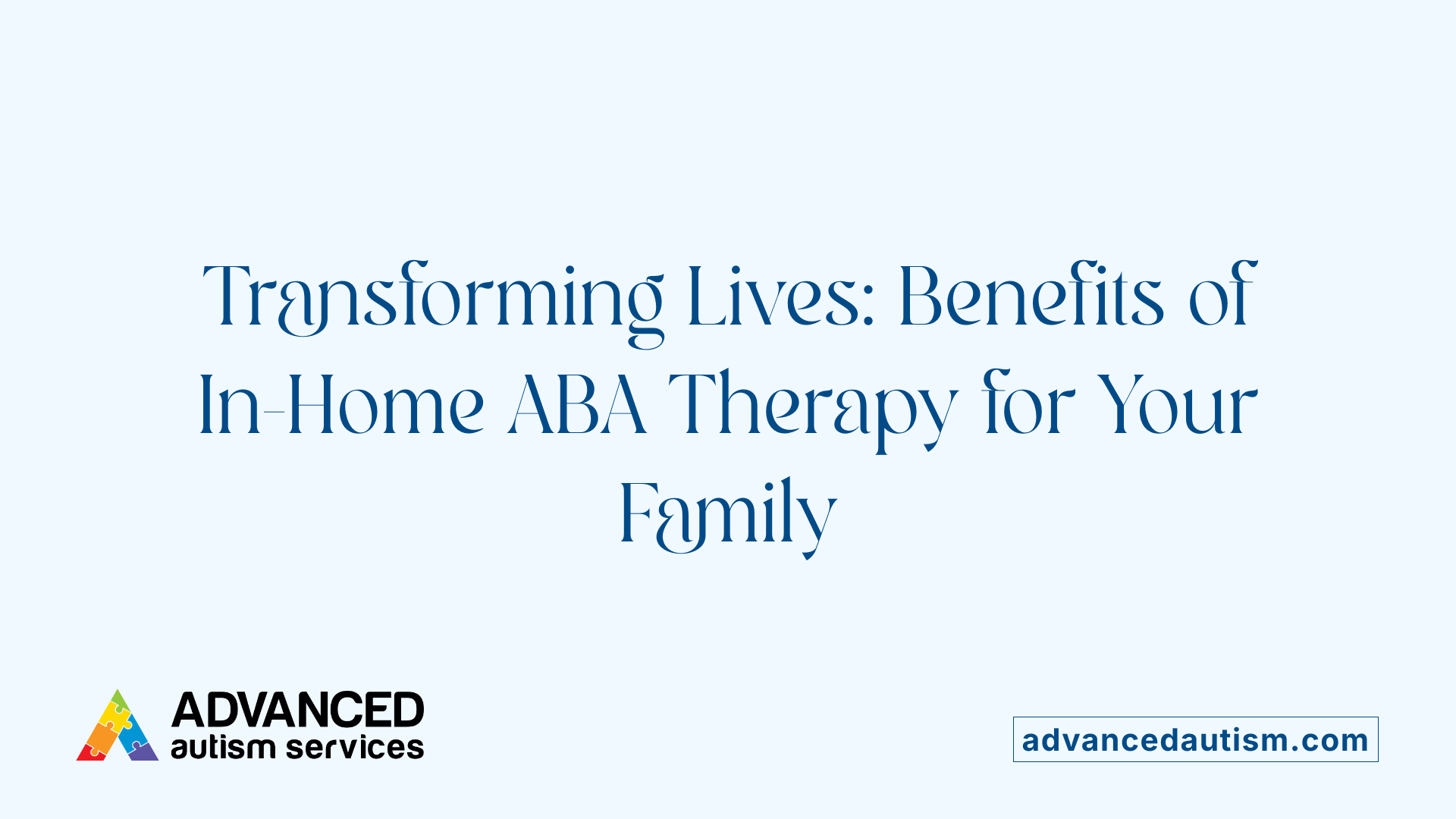Why In-Home ABA Therapy Might Be the Right Choice for Your Family
Transforming Autism Support with Personalized In-Home ABA Therapy
Understanding the Significance of In-Home ABA Therapy
Choosing the right therapeutic environment for children with developmental needs is crucial. In-home ABA therapy presents a compelling option by integrating evidence-based practices within the comfort of a child's natural setting. This comprehensive approach not only enhances skill acquisition but also fosters independence, active family involvement, and meaningful progress tailored to each child's unique profile.
Personalized, Natural Environment Interventions

How does in-home ABA therapy tailor interventions to fit the child's daily activities?
In-home ABA therapy is designed to customize interventions based on a child's unique daily routines and environment. Therapists observe and analyze the child's typical activities—like brushing teeth, setting the table, or playing with siblings—and incorporate these into the therapy plan. This approach ensures that learning is relevant and directly applicable to everyday life.
By embedding teaching moments within familiar tasks, therapists can target specific skills needed for independence and practical living. This personalized focus helps children learn more efficiently and increases the likelihood of skills generalizing to other settings.
How is the child’s home used as a natural learning environment?
The child's home is a familiar and comfortable setting, which reduces anxiety and distractions often associated with clinical environments. This natural setting allows for hands-on, real-world practice of skills, making therapy less intimidating and more engaging.
In this environment, children have spontaneous opportunities to learn—whether during play, mealtime, or routines like dressing or cleaning. The home setting also supports a holistic approach, addressing behavioral and social goals within familiar contexts.
How does incorporating daily routines help develop real-world skills?
Daily routines offer practical opportunities for children to develop essential skills in context. For example, practicing communication during mealtime or social skills during family activities helps children see the relevance of their learning.
Therapists can systematically teach skills like requesting, turn-taking, or self-care during these routines, which promotes automaticity and retention. As a result, children become more capable of applying what they learn to everyday situations, fostering independence and confidence.
Benefits of Using Natural Settings and Routines
Utilizing the child's natural environment and daily routines leads to
- Better skill generalization beyond therapy sessions
- Increased motivation due to relevance
- Reduced stress by avoiding unfamiliar settings
- Opportunities for spontaneous learning
This approach transforms therapy into a seamless part of daily life, strengthening the child's ability to function and communicate effectively in real-world scenarios.
| Aspect | Benefits | Examples |
|---|---|---|
| Tailoring Interventions | Meets individual needs, improves relevance | Using child's favorite activities for teaching skills |
| Natural Learning Environment | Enhances comfort, reduces anxiety | Practicing social skills during family outings |
| Developing Real-World Skills | Promotes generalization and independence | Teaching bathroom routines during daily hygiene |
Both in-home therapy and the incorporation of the child's daily routines play a crucial role in promoting meaningful and lasting improvements. The personalized, natural environment approach makes learning relevant, effective, and seamlessly integrated into the child’s daily life.
Effectiveness Compared to Other Settings

How does in-home ABA therapy compare to other settings in terms of effectiveness?
Research indicates that both in-home and center-based ABA therapy can produce positive outcomes for children with developmental needs, including autism. No single setting has been proven universally superior, and each approach offers distinct advantages depending on the child's individual circumstances.
In-home ABA therapy has the benefit of working within the child's natural environment, which helps in the generalization of new skills to daily life. It involves family participation, making it easier to reinforce strategies throughout routines. Children often feel more relaxed and comfortable at home, which can enhance focus and learning.
On the other hand, center-based ABA therapy offers a more structured setting equipped with specialized tools, resources, and a multidisciplinary team of professionals. This environment minimizes distractions and fosters social interactions with peers, helping children develop social skills in a setting that simulates school or community environments.
Studies suggest that children might learn more exemplars per hour in a structured, clinical setting, partly because of the controlled environment and opportunities for socialization. However, the naturalistic approach of in-home therapy supports skill transfer and consistency, especially for behaviors that are context-dependent.
The decision on the best setting should be personalized, taking into account the child's developmental stage, behavioral challenges, family logistics, and preferences.
Advantages and considerations of each setting
| Setting | Benefits | Challenges | Suitability |
|---|---|---|---|
| In-home ABA | Natural environment; family involvement; comfort; supports generalization | Less structured; dependent on home environment variables | Children who benefit from familiar surroundings and require ongoing family participation |
| Center-based ABA | Structured routines; access to specialized tools; peer interaction | Less natural setting; transportation needed | Children who thrive in structured environments and benefit from socialization opportunities |
Choosing the right environment
When deciding between in-home and center-based ABA therapy, families and professionals should consider the child's specific needs, behavioral goals, and practical factors such as accessibility, insurance coverage, and family preferences. Both settings can be effective, and some children may benefit from a combination approach, transitioning between settings as they develop.
Ultimately, matching the therapy environment to the child's unique situation—while ensuring high-quality, consistent intervention—is crucial to achieving the best possible outcomes.
| Factors Influencing Choice | Considerations | Impact on Effectiveness | Additional Notes |
|---|---|---|---|
| Child's Behavioral Needs | Sensory sensitivities, social skills, independence levels | Tailors environment to maximize learning | For highly sensitive children, home may be less overwhelming |
| Family Involvement | Availability of parents and caregivers | Enhances learning reinforcement | Active participation increases generalization |
| Accessibility and Cost | Location, insurance, scheduling | Affects feasibility and consistency | Sometimes a combination approach is the most practical |
| Developmental Goals | Skill acquisition focus, social skills, independence | Guides environment choice for targeted skills | Both settings can be adapted to meet goals |
Choosing between in-home and center-based ABA therapy involves understanding each setting's strengths and challenges. A personalized approach, considering the child's needs and family circumstances, helps optimize the effectiveness of the intervention.
Methodology and Approach of In-Home ABA Therapy

How does in-home ABA therapy work and what is its methodology?
In-home ABA therapy offers a personalized and structured approach to supporting children with developmental challenges and autism. The therapy is designed to improve specific skills and reduce challenging behaviors by integrating interventions into the child's natural home environment, making learning more relevant and effective.
The process begins with a comprehensive assessment conducted by qualified behavior analysts, often supervised by Board Certified Behavior Analysts (BCBAs). This assessment helps identify the child's strengths, challenges, and goals, forming the basis for an individualized treatment plan.
Once the plan is in place, therapy sessions are tailored to the child's daily routines and environment. Therapists use a variety of evidence-based techniques such as positive reinforcement, prompting, shaping, fading, and modeling. These strategies help teach communication, social skills, self-care, and adaptive behaviors in real-world contexts.
Data collection is a vital component of in-home ABA therapy. Therapists continuously monitor progress, track behaviors, and adjust interventions as needed. This ongoing evaluation ensures that the therapy remains effective and responsive to the child's evolving needs.
Family involvement is essential throughout the process. Parents and caregivers are trained to reinforce learning, practice new skills, and apply behavioral strategies during daily activities. This collaborative approach promotes consistency and helps children generalize skills across different settings.
By focusing on natural interactions and everyday routines, in-home ABA therapy not only facilitates meaningful skill development but also minimizes disruptions and stress for children. It embodies a science-based approach that empowers families to actively participate in their child's growth and progress.
Benefits for Families and Children

What are the advantages of in-home ABA therapy for families and children?
In-home ABA therapy offers significant benefits that cater to the unique needs of children and their families. One of the main advantages is convenience. Since therapy sessions occur in the child's natural environment, families save time and reduce stress associated with travel and scheduling conflicts. This setup makes it easier to fit therapy into daily routines, providing a seamless integration of interventions.
Children also experience less anxiety and stress when receiving therapy at home. They are in a familiar, comfortable setting, which helps them relax and focus better during sessions. This environment encourages natural behavior and makes learning more effective.
Family participation plays a vital role in in-home ABA therapy. Parents and caregivers are trained to reinforce strategies, participate actively in sessions, and apply techniques across daily routines. This involvement promotes consistency, increases the child's generalization of skills, and fosters a stronger parent-child bond.
The personalized approach of in-home therapy ensures interventions are tailored to each child's specific routines, preferences, and developmental goals. Therapists can adapt strategies based on real-time observations within the child's daily environment, leading to more meaningful and lasting improvements.
Furthermore, therapy in the home supports the development of real-world skills. Children practice behaviors like social interactions, hygiene routines, and play within their typical context, which helps them generalize learned skills to everyday situations.
In summary, in-home ABA therapy provides a practical, comfortable, and highly individualized approach, promoting better engagement, faster progress, and stronger family involvement—all crucial for supporting a child's development.
Why Families Should Consider In-Home ABA Therapy

Why should families consider in-home ABA therapy as a suitable option?
Families exploring support options for their children often prioritize environments that foster comfort, familiarity, and practical skill development. In-home ABA therapy stands out because it provides a highly personalized setting tailored specifically to the child's daily life. When therapy takes place within the comfort of their own home, children tend to feel less anxious and more open to learning.
This setting allows therapists to seamlessly integrate interventions into daily routines, such as brushing teeth, setting the table, or playing with siblings. These natural activities create real-world contexts for skill-building, making learning more relevant and easier to generalize outside of therapy sessions.
Active involvement of family members enhances the effectiveness of the approach. Parents and siblings can observe and participate during sessions, which promotes consistent reinforcement of strategies and immediate feedback. This collaboration strengthens bonds, empowers parents with techniques they can apply daily, and accelerates progress.
In addition, in-home ABA therapy minimizes environmental changes that can cause stress or distraction for children sensitive to new settings. It builds trust between the child and the therapist, fostering a supportive atmosphere conducive to progress.
Flexibility is another major advantage. In-home services often offer adaptable scheduling to fit busy family routines. This flexibility removes logistical barriers like travel and availability issues, making consistency more feasible.
Overall, in-home ABA therapy offers a comprehensive approach that blends personalized care, seamless routine integration, and family engagement—ultimately creating a supportive environment where children can thrive and develop key life skills effectively.
Factors to Consider When Choosing a Provider
What factors should families consider when choosing in-home ABA therapy?
Selecting the right in-home ABA therapy provider is a vital step towards supporting a child's development. Families should first verify that the therapists involved possess proper qualifications and experience. The most qualified providers typically employ Board Certified Behavior Analysts (BCBAs) and trained behavior technicians who adhere to evidence-based practices.
Next, the customization of therapy plans stands out as a crucial aspect. Effective plans are tailored to meet the individual needs, strengths, and goals of each child. Regular progress monitoring and transparent communication are essential to ensure that therapy remains aligned with evolving needs.
Family involvement plays a pivotal role in the success of ABA therapy. Providers who encourage active participation, including training parents and caregivers, help reinforce skills outside of therapy sessions. This involvement fosters consistency and maximizes the child's progress.
Practical considerations such as scheduling flexibility and environmental suitability should not be overlooked. Flexible scheduling accommodates family routines and commitments, while the home environment provides natural opportunities for skill generalization.
Additional factors include the provider’s reputation, experience with in-home settings, and coverage through insurance plans. These elements influence the ease of accessing services and the overall effectiveness of the therapy.
In summary, families should seek providers with qualified staff, personalized plans, strong family collaboration, and practical logistics to create a seamless, effective therapy experience tailored to the child's unique needs.
Conclusion: The Value of a Personalized Approach
When it comes to supporting children with developmental needs, particularly those on the autism spectrum, a personalized approach to therapy can make all the difference. In-home ABA therapy stands out as an effective option that offers numerous benefits tailored to each child's unique situation.
One of the main advantages of in-home ABA therapy is its ability to create a comfortable, stress-free environment. Children are more likely to engage and learn when they are in familiar surroundings, reducing anxiety and distractions that often occur in unfamiliar clinical settings. This natural setting facilitates the generalization of new skills to everyday life, making learned behaviors more meaningful and lasting.
The therapy is highly adaptable, allowing behavior analysts and therapists to modify interventions based on real-time observations of how a child responds in their home environment. This flexibility ensures that treatment plans are personalized, relevant, and capable of addressing the child's specific needs and routines. For instance, therapists can incorporate daily activities like brushing teeth, setting the table, or playing with siblings, turning routine moments into valuable learning opportunities.
Family involvement is a cornerstone of in-home ABA therapy. Parents and caregivers are encouraged to observe sessions, participate, and learn techniques that reinforce positive behaviors. This active participation not only empowers families but helps integrate therapy strategies into daily routines, promoting consistency and more effective skill development.
Moreover, in-home therapy offers greater convenience, eliminating some logistical hurdles associated with clinic visits, such as travel time and scheduling conflicts. By fitting therapy into daily life, families can better commit to ongoing intervention, which is crucial for meaningful progress.
Therapists working in homes can also collaborate closely with family members, gaining insights into challenges and successes within the natural environment. This collaboration results in more tailored and effective treatment plans, ensuring that interventions are relevant and impactful.
Choosing between in-home and other settings depends on individual needs, preferences, and logistics. However, the personalized nature of in-home ABA therapy makes it especially suitable for children who thrive in familiar settings or for families seeking active involvement. Both parents and professionals can find that this approach provides a flexible, effective pathway to supporting a child's growth and independence.
In summary, in-home ABA therapy offers a comprehensive, adaptable, and family-centered approach that aligns with each child's unique needs. It emphasizes the importance of a supportive environment, active family participation, and tailored interventions—elements that collectively foster meaningful progress in developmental skills.
Empowering Families with In-Home ABA Therapy
Ultimately, selecting in-home ABA therapy enables families to provide their children with personalized, effective, and comfortable treatment that seamlessly integrates into daily life. The combination of professional expertise, natural environment, and active family involvement creates a powerful foundation for meaningful developmental progress. With careful consideration of the child's individual needs and circumstances, in-home ABA therapy can be a transformative approach, fostering independence, confidence, and quality of life for children and their families.
References
- In-Home ABA Therapy Might Be the Best Choice for Your ...
- Why In-Home ABA Therapy Works So Well for Kids
- Home-Based or Center-Based ABA Therapy: Which is Best?
- ABA Therapy at Home vs Clinic-Based: Which Is Right for ...
- ABA Therapy In-Home vs At a Center: 5 Key Differences
- Why Home-based ABA Therapy Is A Gamechanger
- What are the benefits of in-home ABA therapy?







